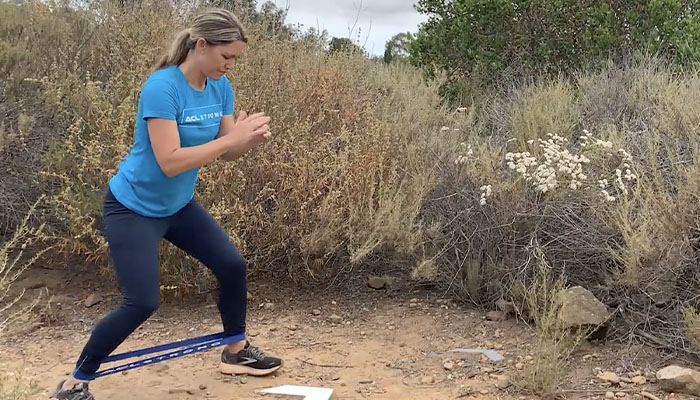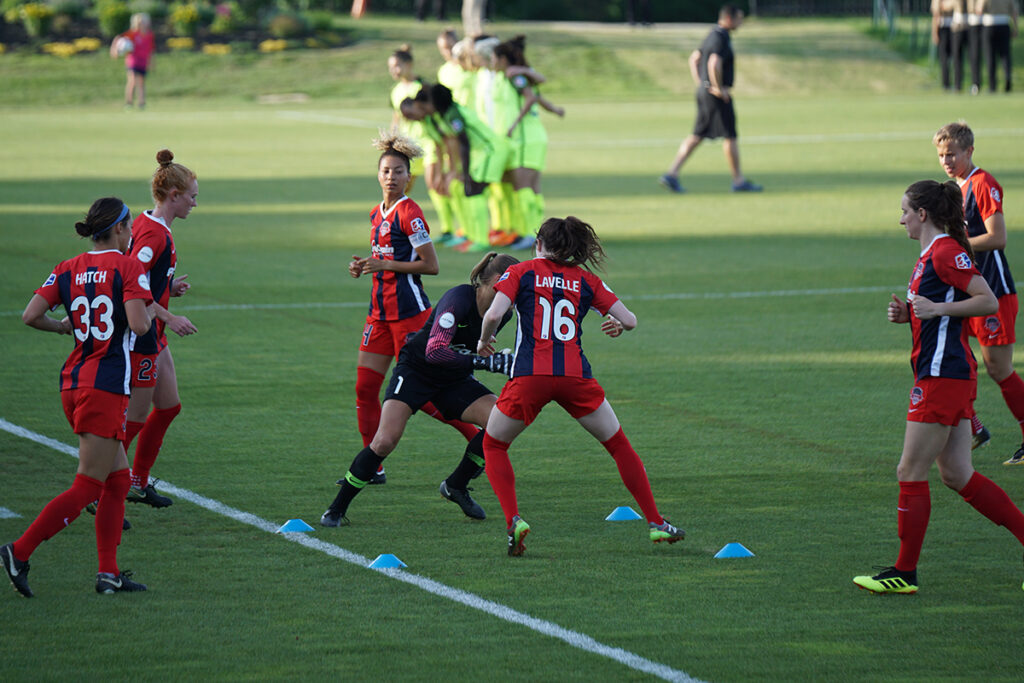If female athletes still start training with “two laps and static stretches,” it’s time to expand their warm-up routine and set them up for success, not injury. Discover how to prevent injuries and improve performance with a step-by-step dynamic warm-up, like professional coaches and trainers do with elite athletes.
For years, the warm-up for football, basketball and soccer players was to jog a lap or two and then sit in a circle for static stretching. However, times have changed and research shows that relying solely on the traditional static stretching method can actually contribute to the high frequency of injuries in youth athletes. We are now in the age of dynamic warm-ups, which have been proven to improve performance and reduce injuries.
Unfortunately, the value of a good warm-up is often underestimated or misunderstood. Most people don’t learn how to maximize the first 15-30 minutes of practice or pre-game, and the result can ultimately be detrimental to your athlete.
In this article we are going to discuss
- The difference between static and dynamic warm-ups
- How warm-up activities affect game performance
- How a warm-up can help prevent injuries
- How to design a dynamic warm-up using an 8-point process
- Tips for implementing a warm-up and maximizing time spent
- How coaches and parents can help athletes go from struggling with adversity to charting their path to a dynamite college career
Static vs. dynamic stretching
Unlike static stretching, which stretches the muscles and holds them for an extended period of time, a dynamic warm-up involves continuous active movements that mimic the movements and intensity of the sport or activity to be followed. These movements typically involve a combination of stretches, bodyweight exercises, and exercises that improve mobility, increase blood flow, activate the central nervous system, and increase body temperature. Read more about the benefits of a dynamic warm-up here (available soon).
Impact on gaming performance
Athletes on a field or court are expected to give 100% in games, right? They sprint, jump, cut, spin, plant, accelerate, decelerate and react with full intensity during competition. So why not prepare their bodies for this level of play during the warm-up? First, those who don’t maximize their warm-up time may spend the first half of the game ramping up to full intensity, and in the meantime, they’ll fall behind on the leaderboard and have to play catch-up to have a chance at victory. . We’ve all seen that happen.
A proper warm-up will not only prepare athletes to dominate from the first whistle, but their chances of sustaining a season-ending injury, such as a torn ACL, will also be significantly reduced.
Injury prevention
On practice or training days, maximizing “warm-up time” can effectively reduce the risk of injury, improve performance, build strength and resilience, and sharpen athletic focus without wasting time.
Designing an effective warm-up involves creating a targeted series of exercises that target the specific movements and muscles used in the sport. As a direct result, athletes experience the benefits of increased blood flow, better flexibility, neuromuscular activation, and both physical and psychological preparedness.
8-point process to amp up your warm-up, plus 4 bonus tips for dynamite results
To enhance your warm-up, follow this 8-point process, using dynamic stretching and neuromuscular training elements, and watch your team rise to a higher level of play and achieve greater success as a result.
1. Start with light cardio
Start your warm-up with 5-10 minutes of light cardio exercise such as jogging, jumping rope or a sport-specific activity to increase heart rate, body temperature and circulation. This helps prepare the cardiovascular system for activity, prepares the muscles for movement and delivers an increase in blood and oxygen to the muscles for the performance ahead.
2. Dynamic stretching exercises
Keep moving! Perform dynamic stretches that continuously move the joints through a full range of motion, focusing on movements used in the specific sport you are preparing for. Examples include open/close ports, hip hugs, leg swings, walking lunges, arm circles, and trunk rotations. This improves muscle flexibility, lubricates the joints and prepares the tissues for sport-specific movements.
3. Multi-directional movement
Then incorporate movements that mimic the actions and demands of the sport, introducing movements in multiple directions. For example, lateral shuffles, zigzag movements and other changes in speed and direction, which are relevant in most field and field sports. This helps simulate sports-like scenarios in offensive and defensive plays and activates pathways from your brain to your muscles so that your body responds quickly and efficiently in a controlled environment. Remember, if you can’t move well in a controlled environment, you certainly won’t be able to move well in an unpredictable environment when the players and the ball are moving quickly.
>> Now we get to more advanced elements that are usually overlooked. This is the strength and neuromuscular training phase. You don’t have to do this hard every session, but you can choose to put more emphasis on training days rather than competition days. <
4. Strengthening
Athletes need targeted strengthening for the hips, core and muscle groups relevant to the sport. The old-fashioned methodology didn’t value strengthening for female athletes, but we know better now. Because strength and stability in athletic movements come primarily from the core and hips, focus on glute activation or other strength-based exercises during this phase of your warm-up. As always, adjust this to your age, fitness level and sport. Resistance bands are convenient and easy to transport for extra resistance.
5. Balance exercises
Go deeper into the neuromuscular training phase and challenge balance and stability by balancing on one foot or using an unstable surface. This stimulates the neuromuscular system, improves proprioception and improves overall balance and coordination. You want to prepare the brain and muscles for a potentially awkward cut or landing so that the body can recover safely without getting injured. Focusing on reactive balance can facilitate faster communication pathways from your brain to your limbs.
6. Plyometrics and landing mechanics
As you delve deeper into sport-specific strength movements, add in some explosive exercises such as jumping and jumping as needed, as it will further prepare the muscles, tendons and nervous system for faster acceleration and better performance. ALWAYS check proper landing mechanics, especially with youth female athletes, to ensure they land with good form, which will reduce the risk of a torn ACL. Proper acceptance of force throughout the body is a key factor in preventing serious non-contact injuries.
7. Agility exercises
Speed up now! Add agility, coordination or footwork activities to improve reaction time, speed and body control. Use tools such as agility ladders or cones to develop quick and precise movements in different directions. This improves the ability to reduce and produce force, which benefits overall athletic performance.
8. Reaction and cognitive exercises
This is groundbreaking stuff! Introduce an exercise that challenges rapid decision-making and cognitive processing. Use cues such as colors or numbers to indicate directions or actions, requiring athletes to think, make a decision, and execute in a moment of high intensity. This helps train the brain to process information quickly and improves reaction time and performance on the field. Have fun with this!
Bonus Tips – Remember These Concepts for HOT HOT HOT Results:
- Good form and body control should be a priority during the warm-up.
- Encourage mental focus during the warm-up. Visualize successful passes, plays, attempts and what success looks like. Deep breathing and positive affirmations can support mental preparation, especially on game days when the stakes are higher.
- After a break (rest, sit-out, etc.) it may be necessary to repeat a mini warm-up on the sidelines before play resumes, especially if players have been out in the cold.
- Aim for 15-20 minutes for a standard warm-up, while this can be up to 30 minutes on days when more time is spent on strength, balance, plyometrics, agility or cognitive exercises (steps 4-8). You don’t have to get all these points during every warm-up. That’s where the art comes in. Balance art and science to maximize warm-up time and you’ll develop strong, resilient athletes.
Coaches and Parents: How to Support Developing Athletes
A well-designed dynamic warm-up can be a game-changer for your team and one of your best tools for preparing athletes mentally and physically while reducing injuries on the field or court.
Most people don’t know what to do, especially with neuromuscular training exercises (4-8). It can be overwhelming and confusing because there are so many variations to choose from and it’s hard to know which is best. We’ve seen people struggle through this without being sure they’re doing their best for themselves or their players.
To provide clarity and simplicity, we have drawn up a step-by-step plan so that you do not have to figure it out yourself. If you are a coach or parent of youth female athletes, these exercises can easily be performed at home in 15-20 minutes, or on the field or track during warm-ups, and will help take your athletes from good to excellent. to take. , and from battling injuries to paving their way to a dynamite college career.
We hope you enjoyed reading this perspective on the value of a dynamic warm-up and how to maximize the first 15-30 minutes with your team.












